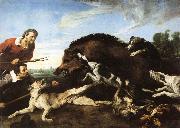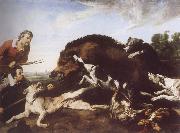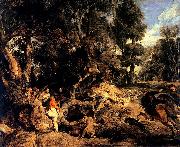Wholesale Oil Painting Reproductions No Minimum and Door to Door! |
|||||||||||
|
|
|||||||||||

|
|||||||||||
|
|
|
||||||||
All Frans Snyders Oil Paintings |
||||||||
|
|
||||||||
|
|
||||||||
|
Artist Introduction: Belgian
1579-1657
Frans Snyders Gallery
Frans Snyders (1579 - 1657), or Snijders, was a Flemish painter of animals and still life.
Snyders was born and died at Antwerp. He is recorded as a student of Pieter Brueghel the Younger in 1593, and subsequently received instruction from Hendrick van Balen, the first master of Van Dyck. He was a friend of Van Dyck who painted Snyders and his wife more than once (Frick Collection, Kassel etc).
He became a master of the Antwerp painters guild in 1602. He visited Italy in 1608-9, visiting Rome, and working for Cardinal Borromeo in Milan. In 1611 he married Margaretha, the sister of Cornelis de Vos and Paul de Vos (another animal painter), in Antwerp. Jan Fyt was a student, and then assistant of his from 1629.
Snyders initially devoted himself to painting flowers, fruit and subjects of still life, but later turned to painting animals, and executed with the greatest skill and spirit hunting pieces and combats of wild animals. He was one of the earliest specialist animaliers.
Snyders and his wife, by Van Dyck, KasselHis composition is rich and varied, his drawing correct and vigorous, his touch bold and thoroughly expressive of the different textures of furs and skins. His excellence in this department excited the admiration of Rubens, who frequently employed him to paint animals, fruit and still life in his own pictures, and he assisted Jacob Jordaens, Thomas Willeboirts Bosschaert and other artists in a similar manner.
In the lion and boar hunts which bear the name of Snyders the hand of Rubens sometimes appears. He was one of the executors of Rubens's will.
He was appointed principal painter to the Archduke Albert of Austria, governor of the Low Countries, for whom he executed some of his finest works. One of these, a Stag-Hunt was presented to Philip III of Spain, who together with his successor Philip IV of Spain, commissioned the artist to paint several subjects of the chase, which are still preserved in Spain. He also worked for Archduke Leopold Wilhelm of Austria, when he became Governor. |
||||||||
|
|
||||||||
|
Wild Boar Hunt Painting ID:: 30017 |
mk67
Oil on canvas
84 1/4x122 7/16in
Pitti,Depository
|
|||||||
Height Width |
INS/CM Quality |
|||||||
|
X |
| |||||||
|
|
||||||||
All Frans Snyders Oil Paintings |
||||||||
|
|
||||||||
|
|
||||||||
|
Artist Introduction: Belgian
1579-1657
Frans Snyders Gallery
Frans Snyders (1579 - 1657), or Snijders, was a Flemish painter of animals and still life.
Snyders was born and died at Antwerp. He is recorded as a student of Pieter Brueghel the Younger in 1593, and subsequently received instruction from Hendrick van Balen, the first master of Van Dyck. He was a friend of Van Dyck who painted Snyders and his wife more than once (Frick Collection, Kassel etc).
He became a master of the Antwerp painters guild in 1602. He visited Italy in 1608-9, visiting Rome, and working for Cardinal Borromeo in Milan. In 1611 he married Margaretha, the sister of Cornelis de Vos and Paul de Vos (another animal painter), in Antwerp. Jan Fyt was a student, and then assistant of his from 1629.
Snyders initially devoted himself to painting flowers, fruit and subjects of still life, but later turned to painting animals, and executed with the greatest skill and spirit hunting pieces and combats of wild animals. He was one of the earliest specialist animaliers.
Snyders and his wife, by Van Dyck, KasselHis composition is rich and varied, his drawing correct and vigorous, his touch bold and thoroughly expressive of the different textures of furs and skins. His excellence in this department excited the admiration of Rubens, who frequently employed him to paint animals, fruit and still life in his own pictures, and he assisted Jacob Jordaens, Thomas Willeboirts Bosschaert and other artists in a similar manner.
In the lion and boar hunts which bear the name of Snyders the hand of Rubens sometimes appears. He was one of the executors of Rubens's will.
He was appointed principal painter to the Archduke Albert of Austria, governor of the Low Countries, for whom he executed some of his finest works. One of these, a Stag-Hunt was presented to Philip III of Spain, who together with his successor Philip IV of Spain, commissioned the artist to paint several subjects of the chase, which are still preserved in Spain. He also worked for Archduke Leopold Wilhelm of Austria, when he became Governor. |
||||||||
|
|
||||||||
|
|
Wild Boar Hunt Painting ID:: 40476 |
mk156
1649
Oil on canvas
214x311cm
|
||||||
Height Width |
INS/CM Quality |
|||||||
|
X |
| |||||||
|
|
||||||||
All Peter Paul Rubens Oil Paintings |
||||||||
|
|
||||||||
|
|
||||||||
|
Artist Introduction: Flemish Baroque Era Painter, 1577-1640
Peter Paul Rubens (June 28, 1577 ?C May 30, 1640) was a prolific seventeenth-century Flemish Baroque painter, and a proponent of an exuberant Baroque style that emphasized movement, color, and sensuality. He is well-known for his Counter-Reformation altarpieces, portraits, landscapes, and history paintings of mythological and allegorical subjects.
In addition to running a large studio in Antwerp which produced paintings popular with nobility and art collectors throughout Europe, Rubens was a classically-educated humanist scholar, art collector, and diplomat who was knighted by both Philip IV, king of Spain, and Charles I, king of England.
Rubens was a prolific artist. His commissioned works were mostly religious subjects, "history" paintings, which included mythological subjects, and hunt scenes. He painted portraits, especially of friends, and self-portraits, and in later life painted several landscapes. Rubens designed tapestries and prints, as well as his own house. He also oversaw the ephemeral decorations of the Joyous Entry into Antwerp by the Cardinal-Infante Ferdinand in 1635.
His drawings are mostly extremely forceful but not detailed; he also made great use of oil sketches as preparatory studies. He was one of the last major artists to make consistent use of wooden panels as a support medium, even for very large works, but he used canvas as well, especially when the work needed to be sent a long distance. For altarpieces he sometimes painted on slate to reduce reflection problems.
His fondness of painting full-figured women gave rise to the terms 'Rubensian' or 'Rubenesque' for plus-sized women. The term 'Rubensiaans' is also commonly used in Dutch to denote such women. |
||||||||
|
|
||||||||
|
|
Wild Boar Hunt Painting ID:: 86799 |
1618-1620
Medium Oil on canvas
Dimensions 137 x 168 cm (53.9 x 66.1 in)
cyf |
||||||
Height Width |
INS/CM Quality |
|||||||
|
X |
| |||||||
|
|
||||||||
|
Prev Next
|
||||||||
|
|
||||||||
|
Related Paintings to Peter Paul Rubens :. |
||||||||
|
|
||||||||
|
CONTACT US |



